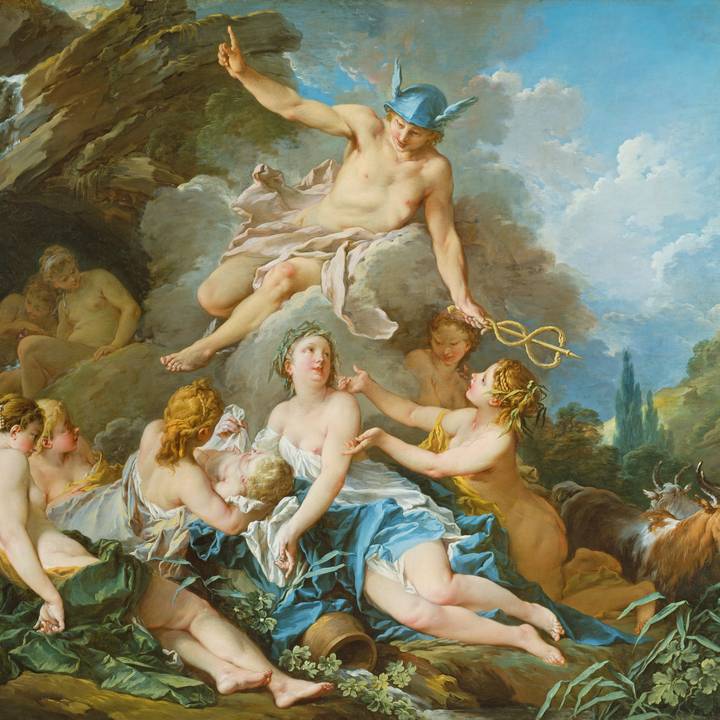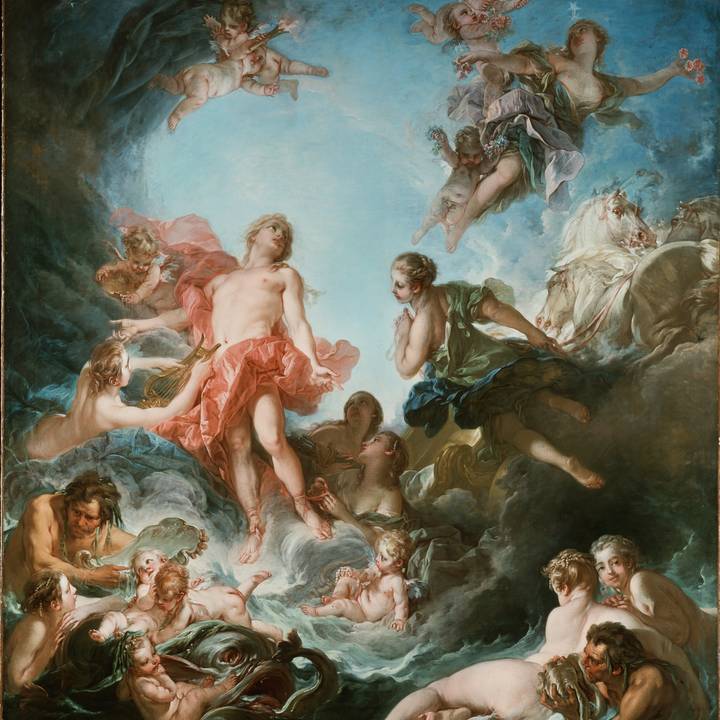Born in Paris in 1703, François Boucher grew up in a family of artisans. His father, Nicolas, was a painter and designer of ornament and embroidery and kept a print shop on the Place du Vieux Louvre. François’s early artistic development could thus be credited to his father.
His father, Nicolas, was a painter and designer of ornament and embroidery and kept a print shop on the Place du Vieux Louvre. François’s early artistic development could thus be credited to his father.
Later, at the age of 17, he became an apprentice in the workshop of the painter François Lemoyne (1688–1737).
Although Boucher only remained in Lemoyne’s workshop for a few months and was reputedly of the opinion that his former master did not teach him much, some characteristics of Lemoyne’s style can certainly be found in Boucher’s early artistic production.
After leaving Lemoyne’s studio, he initially appears to have supported himself through printmaking and the designing of book illustrations, a craft he learned whilst living with the engraver Jean-François des Cars (1661–1730).
It was probably through this work that the Parisian textile manufacturer and art collector Jean de Jullienne decided to employ Boucher to produce a series of etchings after drawings by Antoine Watteau (1684–1721).
In 1723, Boucher won the prestigious Rome Prize, a scholarship that allowed art students to stay at the French Academy in Rome for three to five years. However, he did not manage to go to Rome until about five years later, probably because of financial problems that the Academy was dealing with, and eventually travelled to Italy at his own expense.
He spent the years 1728–31 there, studying the masters of the Baroque and looking closely at contemporary Venetian painting.
Not much is known of this period spent in Italy, but apart from Rome he certainly visited Genoa, Ferrara and Venice.
On his return to Paris in 1731, Boucher focused on large-scale mythological paintings and gained immediate recognition from the Royal Academy, where he became a full member in 1734.
From thereon, Boucher’s career progressed at an exceptional rate, and he became a sought-after artist in the highest circles of society.
His work was particularly favoured by Louis XV, and he was the favourite artist of the king’s mistress Madame de Pompadour, whom Boucher taught in the arts of drawing and engraving as a private tutor.
He received multiple commissions to paint decorations at some of the royal châteaux, amongst which Versailles, Fontainebleau and Choisy.
His large-scale paintings often portrayed mythological subjects, but Boucher also helped popularise the pastoral scene: light-hearted and highly idealised depictions of life in the countryside.
Apart from paintings, he created drawings and designs for all kinds of decorative arts and even theatre stage sets.
We can find scenes designed by Boucher on objects such as Sèvres porcelain and tapestries, in particular those made by the Beauvais and Gobelins manufactories.
In 1753, Madame de Pompadour commissioned Boucher to make full-scale models of the Rising and Setting of the Sun to be woven as tapestries by the Gobelins, which later adorned the king’s bedroom at the château de Bellevue.
Part of Boucher’s ingenuity lay in his capabilities to market his work, and many of his designs spread through the medium of printmaking.
Apart from a number of prints he produced himself, about 1500 prints after Boucher, which served as models for other artists and different media, are known today.
Boucher’s studio also produced many successful artists that followed in his footsteps, amongst the most notable being Jean-Honoré Fragonard (1732–1806).
During the latter part of his career, however, Boucher’s style and choice of subject matter also received criticism.
The anti-Rococo sentiments of several critics, such as Denis Diderot (1713–1784), in the 1750s and 60s condemned the repetitiveness of Boucher’s compositions and the lightness of the subject matter as frivolous, coinciding with the first stirrings of the Neoclassical style.
Regardless of such criticism, Boucher’s work remained in high demand.
In 1765 he was granted two of the highest honours a painter could receive at that time: he was appointed court painter to the king, as well as director of the Royal Academy.
François Boucher died in Paris in 1770.
By then, his name was generally understood as synonymous with that of the mature Rococo style and its spread and popularity throughout Europe.



